
California Schools Pay Students To Educate Teachers About Racism
April 1, 2024
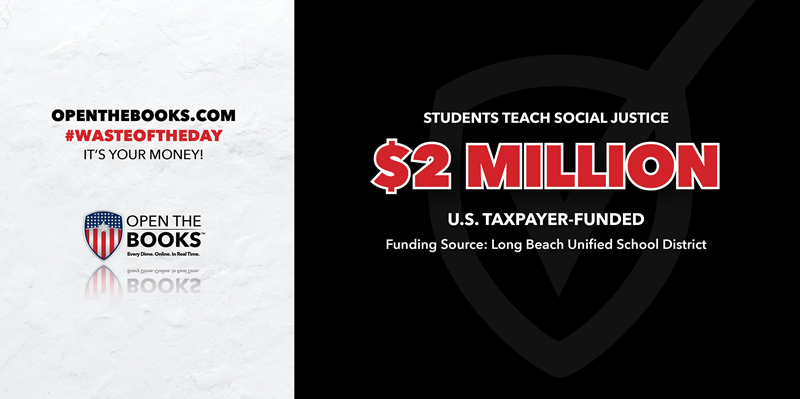
Topline: A California school district used $2 million of taxpayer funds to train high schoolers to fight for racial and social justice, according to records obtained by The Free Press.
Key facts: Long Beach Unified School District hired the group Californians for Justice in 2019 to give equity and leadership training to students and teachers in its 84 schools.
As part of the contract, which is still ongoing, 78 students and 13 parents received stipends of about $1,400 to participate in internships with CFJ.
Among other programs, Californians for Justice hosted 15 student-led training sessions for teachers. High schoolers taught their own teachers about implicit bias and racism, costing the school $25,000. Teachers skipped programs about designing lesson plans to attend the sessions, The Free Press reported.
CFJ’s website says its goal is to “organize marginalized youth, particularly young people of color, immigrant, low-income, and LGBTQ youth to create the healthy, just and vibrant schools all our communities deserve.”
Last October, the group made an Instagram post describing Israel’s war in Gaza as “ethnic cleansing and apartheid orchestrated by white supremacist settler colonialism bent on the goal of wiping out the indigenous Palestinian population.”
Background: Auditors at OpenTheBooks found that Long Beach Unified Superintendent Jill Baker is among the highest-paid employees in all of California with over $371,000 in earnings in 2022.
There were 106 more educators making over $150,000 at the school district in 2022.
Critical quote: Jay Goldfischer, a history teacher in Long Beach, told The Free Press that “One of the reasons that [CFJ] was hired is to help our students find their voice and be able to express it, but in reality, CFJ is not helping students find their own voices. It’s giving them a scripted voice that’s not their own. They’re teaching them parroting, which is the exact opposite of how you empower children.”
Another school employee called the stipends for students and teachers a “horrible propaganda strategy.”
Supporting quote: “Our agenda is not hidden and is simple: we want the Long Beach Unified School District to be a place where every student is represented honestly in classrooms and curricula, and where they are safe to be in critical dialogue supportive of democratic participation across differences,” a CFJ spokesperson told The Free Press in an email.
Summary: Perhaps the taxpayer money used for high schoolers to run their own classes should be reserved to teach students math and reading.
Feds Paid $1.3 Billion To Dead People Last Year
April 2, 2024
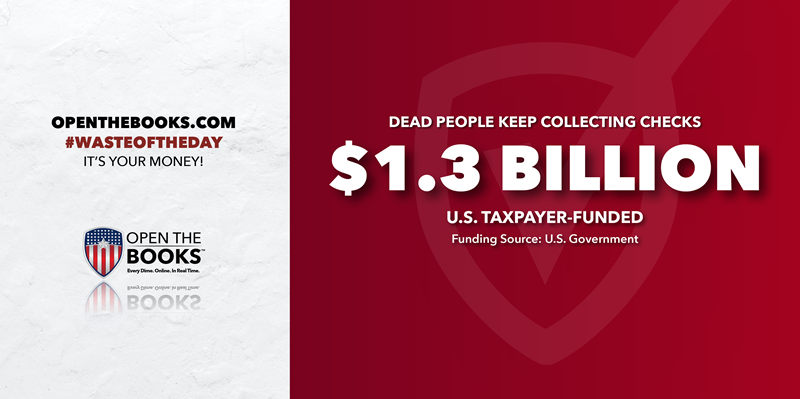
Topline: The federal government mistakenly paid $1.3 billion to dead people in fiscal year 2023, according to U.S. Office of Management and Budget’s reporting on improper payments.
Key facts: Some living souls collected checks for the deceased through alarming examples of fraud at the expense of the IRS, Veterans Affairs Department and Medicare, the Washington Times reported.
One Washington man, Raymond Kenneth Musgrove, impersonated a Vietnam veteran for more than 25 years to collect his disability and health care benefits, the news outlet reported.
When the real veteran died in 2018, the VA cut off benefits — until Musgrove convinced them the veteran was still alive.
Payments stopped again once the VA inspector general found the veteran’s tombstone in an Oklahoma cemetery, but Musgrove somehow duped the VA again and payments restarted, the Times reported.
Musgrove collected $825,000 before his indictment this February.
A woman in Ohio kept a similar scam going for 48 years, lying to the VA seven times to collect benefits for her dead mother, until being caught in 2021, the newspaper said.
Background: Not all improper payments are quite so amusing, but they do amount to a staggering amount of taxpayer money thrown down the drain.
OpenTheBooks previously reported that the federal government spent $2.9 trillion on improper payments between 2004 and 2022, adjusted for inflation. That’s 8% of the current $34.5 trillion national debt.
Another $236 billion was incorrectly paid in 2023, according to the Government Accountability Office.
Of that, $1.3 billion were payments made to dead people.
Summary: While completely eliminating improper payments is unlikely, cutting off funds after seeing the beneficiary’s tombstone is a good place to start.
Unknown Amount of U.S. Aid to Afghanistan Went to Taliban
April 3, 2024
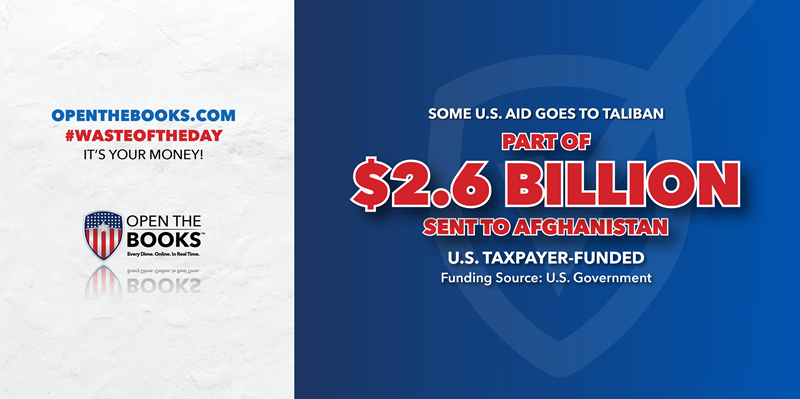
Topline: The United States has sent $2.6 billion of humanitarian aid to Afghanistan since August 2021, some of which wound up in the hands of the Taliban terrorist organization, according to a recent Inspector General report.
Key Facts: Afghanistan does not have the infrastructure to support electronic money transfers, so the United Nations flies stacks of physical U.S. cash into the country. The money goes to groups fighting the drought and famine in the region.
Sometimes the groups can use the U.S. dollars, but they also need afghanis — Afghanistan’s currency — to pay employees and vendors. So, the groups exchnage their cash through private banks.
But many private banks in Afghanistan do not have enough afghanis to support the U.N., since the Taliban controls the money supply.
To get more afghanis, the private banks auction off the U.N. cash to the highest bidder. Oftentimes, that’s the Taliban-controlled Da Afghanistan Bank, which makes a profit for the Taliban because of the currency exchange rate.
Once the exchange occurs, the same physical U.S. dollars flown in by the U.N. are now held in the Taliban’s bank.
The Taliban sometimes removes money from circulation to inflate the value of the afghani, helping them make even more profit from the exchange.
The U.N. has released statements that it does not provide cash to the Taliban or DAB. Yet the exchange process happens with the U.N.’s knowledge, according to the Inspector General.
Background: The international community paused all funding to Afghanistan when the Taliban returned to power in 2021 but restarted it in early 2022 when the humanitarian crisis worsened.
The U.N. has sent $2.9 billion to Afghanistan since 2021. $2.6 billion of it came from the American government, including $1.7 billion from the U.S. Agency for International Development.
The report did not specify how much of the money went to the Taliban.
Critical quote: “Most of the money that’s going in cash through the U.N. is ultimately coming from U.S. taxpayers,” John Sopko, the inspector general, said in an interview with ProPublica. “It’s going to a terrorist group. The Taliban are a bunch of terrorists.”
Supporting quote: “The UN seriously considered the risks of money laundering and terrorist financing in deciding to cease the use of international wire transfers and instead to physically transport U.S. currency to Afghanistan for payment to implementing partners,” the State department wrote in their response to the report. “No electronic financial delivery systems are currently scalable and able to meet the liquidity needs of the UN so that it may deliver assistance responsibly to benefit the millions of Afghans in need.”
Summary: As taxpayer spending increases with new crises in Israel and Ukraine in addition to Afghanistan, it’s more important than ever that foreign aid is tracked and safeguarded.
Throwback Thursday: Taxpayers Fund $5 Million Luxury Entrance At St. Louis Zoo
April 4, 2024
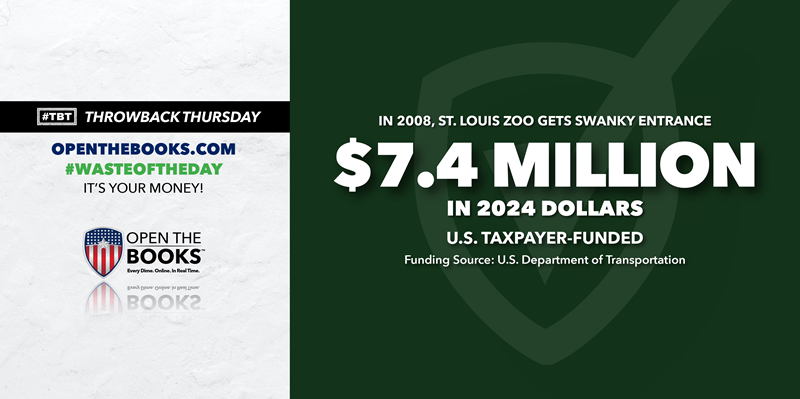
Throwback Thursday!
Topline: The federal government spends millions each year to help zoos throughout the country care for their animals.
But in 2008, the federal Department of Transportation spent $5 million for a less vital program: giving animals at the St. Louis Zoo a splendid front entrance to admire, costing $7.4 million in today’s money.
That’s according to the “Wastebook” reporting published by the late U.S. Senator Dr. Tom Coburn. For years, these reports shined a white-hot spotlight on federal frauds and taxpayer abuses.
Coburn, the legendary U.S. Senator from Oklahoma, earned the nickname "Dr. No" by stopping thousands of pork-barrel projects using the Senate rules. Projects that he couldn't stop, Coburn included in his oversight reports.
Coburn's Wastebook 2008 included 65 examples of outrageous spending worth more than $1.3 billion, including the $5 million in funds for the St. Louis Zoo.
Key facts: The project started as an effort to improve safety at the entrance to the zoo after a drunk driver fatally struck a visitor.
But after building a pedestrian bridge, the zoo used taxpayer funds on expensive decorations for the new entrance.
Visitors were able to walk past a model African savanna and a series of bronze sculptures, including a 19-foot tall elephant statue. At 2.5 tons, it weighs half as much as an actual elephant.
Never mind that the entrance was already adorned with concrete letters spelling out the word “zoo.” Those were relocated to clear space for the expensive refurbishment.
Former Sen. Christopher Bond (R-MO) earmarked the funds in 2006. Another $2.5 million in private funding was also used.
Background: Congress banned earmarks in 2010 because of concerns they could fund wasteful spending such as the St. Louis Zoo entrance. However, they were reinstated in 2021 and continue to give lawmakers a way to fund projects that align with their own political agendas.
Coburn called earmarks a “currency of corruption” and often fought to remove them from spending packages.
Auditors at OpenTheBooks.com have already reviewed the first six of 12 bills that will fund the federal government this year and have found almost 6,600 earmarks worth nearly $14 billion.
Summary: Perhaps a $5 million grant would have been better spent on taking care of live elephants instead of building bronze statues of them.
Report Shows Major Cities In Debt
April 5, 2024
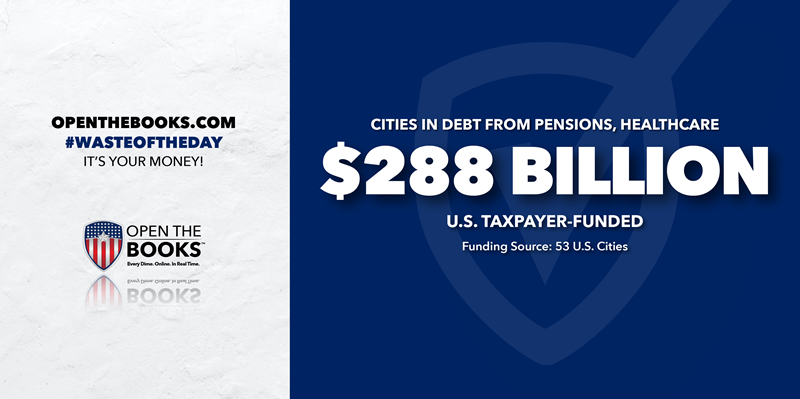
Topline: The 75 largest cities in America were collectively $288 billion in debt at the end of fiscal year 2022, according to think tank Truth in Accounting.
Key facts: The new “Financial State of the Cities” report found 53 major cities that do not have enough money to pay their bills.
Yet all of them claimed their budgets were balanced, as is required by law. That means lawmakers understated each city’s debt by not including future costs like employee pensions and healthcare, according to Truth in Accounting.
The report ranked cities based on their “taxpayer burden”: the amount each taxpayer would need to spend for the government to pay off all its debt tomorrow.
New York City has a taxpayer burden of $61,800, the largest by far despite being the most populous. The city has only six cents saved up for every dollar it will need to spend on retiree healthcare.
Chicago was the second-worst and would need $42,900 from each taxpayer to pay off its debt. That’s partly because the city’s pension liability increased by $1.7 billion in 2022.
Honolulu, Philadelphia and Portland, Oregon round out the five most burdened cities.
Washington, D.C. was the healthiest of 22 cities with a taxpayer surplus. There would still be $10,700 left over for each taxpayer if the city paid all its debt.
Irvine, California and Plano, Texas are the only other two cities on the list with a taxpayer surplus above $5,000.
Background: The 75 cities owned a total of $307.4 billion of assets to pay $595.3 billion in liabilities.
The debt includes $175.9 billion for upcoming employee pensions and $135.2 billion for other retiree benefits.
Still, the numbers pale in comparison to the $34.6 trillion federal debt, and that held by states.
California, New York and Texas, for example, each have more state debt than the 75 cities combined.
Summary: With the constant magnifying glass on federal spending, it can be easy to forget that local governments are still racking up debt at the same time.
The #WasteOfTheDay is presented by the forensic auditors at OpenTheBooks.com.